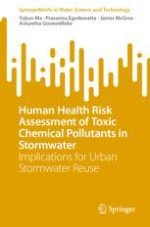This book presents a detailed analysis in relation to human health risk assessment of the main toxic chemical pollutants in urban stormwater generated from urban traffic and land use activities. The knowledge presented in this book was derived based on comprehensive experimental investigations including field sampling, laboratory testing, mathematical modelling, spatial analysis and multivariate and univariate statistical data analyses.
The key highlights of the book include the quantitative assessment of the human health risk posed by key toxic chemical pollutants in urban stormwater and the development of linkages between risk and traffic and land use. Additionally, a suite of mathematical equations are presented to predict human health risk based on traffic and land use characteristics through mathematical modelling. These outcomes can significantly assist in effective stormwater risk management under changing traffic and land use in the urban environment. The knowledge presented is of particular interest to readers such as stormwater treatment design specialists, decision-makers and urban planners since these outcomes provide practical suggestions and recommendations for effective urban stormwater treatment design.
